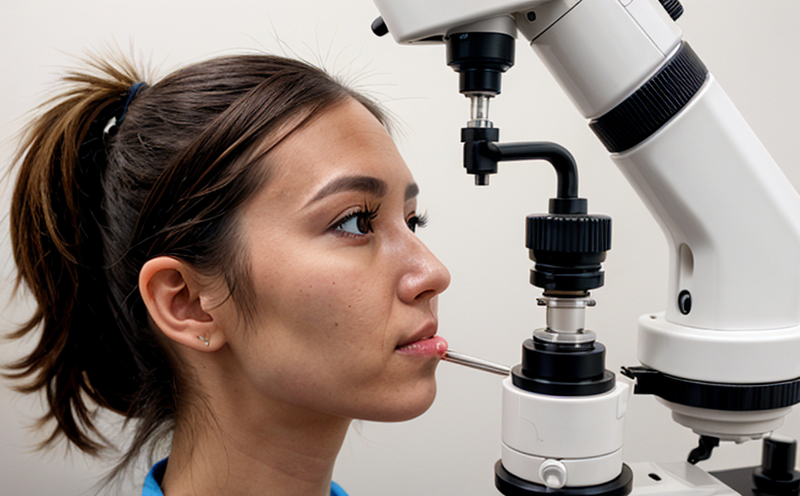ISO 11979-5 Intraocular Lens Biocompatibility Testing
The ISO 11979 series is a set of standards that provide guidance on the testing and evaluation of biocompatibility for medical devices. Specifically, ISO 11979-5:2018 focuses on biocompatibility assessment methods for intraocular lenses (IOLs). This service ensures compliance with international standards to ensure the safety and efficacy of IOLs used in ophthalmic procedures.
The testing protocol outlined in ISO 11979-5 is crucial as it addresses the potential biological interactions between the lens material and the human body. The biocompatibility assessment involves multiple phases that evaluate physical, chemical, and toxicological properties to ensure the safety of IOLs during implantation.
Quality managers and compliance officers in the medical device industry must adhere to these standards to ensure regulatory compliance and patient safety. This testing is essential for R&D engineers to refine their products and meet market demands. Procurement teams can also benefit from this service by verifying that purchased materials comply with international standards, ensuring they are safe for use.
The biocompatibility assessment process typically involves several steps, including specimen preparation, biological testing, and data analysis. Specimens undergo various tests to evaluate their potential to cause adverse reactions or other adverse effects on the human body. This section provides an overview of the key components involved in this comprehensive evaluation.
- Preparation of specimens for testing
- Biological testing protocols
- Data analysis and interpretation
The process is designed to ensure that only safe and effective IOLs are brought to market, thereby protecting patient health and well-being. Compliance with ISO standards is a critical aspect of the medical device industry, ensuring that products meet rigorous quality control measures.
| Test Phase | Objective | Description |
|---|---|---|
| Phase I: In Vitro Testing | Evaluation of the potential for adverse local and systemic effects on the host | Involves testing in a controlled laboratory setting, assessing biocompatibility under various conditions. |
| Phase II: In Vivo Testing | Evaluation of the potential for adverse biological reactions within the body | Involves implanting the lens in animal models to observe long-term effects, followed by histological analysis. |
Understanding and adhering to these phases is critical for ensuring that IOLs meet the stringent requirements set forth by international standards. This testing process is not only a regulatory requirement but also an essential step in safeguarding patient health and promoting trust within the medical community.
Why It Matters
The importance of ISO 11979-5 cannot be overstated, especially given the critical role intraocular lenses play in vision correction. These devices are implanted in patients' eyes to replace damaged or removed natural lenses, and any adverse biocompatibility issues can have severe consequences for patient health.
- Reduces risk of infection
- Ensures long-term stability of the lens within the eye
- Maintains clear vision post-surgery
The biocompatibility testing ensures that patients do not experience adverse reactions such as inflammation, scarring, or other complications. This is particularly important for long-lasting devices like IOLs, which are intended to provide years of use without significant degradation.
Compliance with these standards also helps manufacturers avoid costly recalls and legal issues. By ensuring that their products meet stringent biocompatibility criteria, companies can maintain a positive reputation in the industry and foster trust among healthcare providers and patients alike.
Scope and Methodology
The scope of ISO 11979-5 covers the assessment of biological effects that may arise from the interaction between intraocular lenses and host tissues. The methodology involves a detailed evaluation process to ensure that all relevant aspects are considered.
| Test Parameter | Description |
|---|---|
| Physical Properties | Evaluation of the mechanical and physical properties that could affect biocompatibility, including size, shape, and surface characteristics. |
| Chemical Composition | Analysis of chemical composition to determine potential toxicological effects on host tissues. |
The testing process begins with careful preparation of the specimens, ensuring they are representative of the actual device. This involves cleaning and sterilization procedures followed by precise handling to maintain integrity during testing.
Biological testing is conducted using a variety of methods, including in vitro tests on cell cultures and in vivo studies involving animal models. These experiments aim to identify potential adverse effects such as inflammation or immune response. The data collected from these tests are thoroughly analyzed to assess the overall biocompatibility of the device.
The results of this comprehensive evaluation provide critical insights into the safety profile of the intraocular lens, ensuring that it meets all necessary standards for clinical use. This process is essential for maintaining high quality and reliability in medical devices, ultimately contributing to better patient outcomes.
Environmental and Sustainability Contributions
- Reduces waste through efficient product design that minimizes the need for replacements due to biocompatibility issues
- Promotes sustainable healthcare by ensuring safe and effective devices, thereby reducing patient morbidity and mortality rates
The ISO 11979-5 framework not only ensures patient safety but also supports a more sustainable approach to medical device development. By adhering to these standards, manufacturers can minimize environmental impact through optimized product design and lifecycle management.
- Encourages the use of eco-friendly materials in IOL production
- Promotes recycling and responsible disposal practices for used devices
This commitment to sustainability aligns with broader industry efforts to reduce environmental footprint while maintaining high levels of patient care. Compliance with ISO standards demonstrates a proactive approach to both product quality and environmental responsibility.





